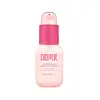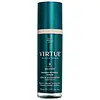What's inside
What's inside
 Key Ingredients
Key Ingredients

 Benefits
Benefits

 Concerns
Concerns

 Ingredients Side-by-side
Ingredients Side-by-side

Water
Skin ConditioningCetearyl Alcohol
EmollientGlycerin
HumectantSh-Oligopeptide-78
Behenyl/Stearyl Aminopropanediol Esters
Arginine
MaskingItaconic Acid
AntimicrobialPanthenol
Skin ConditioningLinum Usitatissimum Seed Extract
PerfumingSalvia Hispanica Seed Extract
EmollientPolyglyceryl-10 Laurate
Skin ConditioningHydrolyzed Hyaluronic Acid
HumectantCocos Nucifera Water
MaskingPsidium Guajava Fruit Extract
AstringentSodium Hyaluronate
HumectantHydrolyzed Wheat Protein
Skin ConditioningHydrolyzed Wheat Starch
Skin ConditioningGuar Hydroxypropyltrimonium Chloride
Skin ConditioningCaprylic Acid
CleansingSorbic Acid
PreservativeTetrasodium Glutamate Diacetate
Xylitol
HumectantCoumarin
PerfumingBenzoic Acid
MaskingBehentrimonium Chloride
PreservativeCetrimonium Chloride
AntimicrobialBenzyl Alcohol
PerfumingParfum
MaskingHexyl Cinnamal
PerfumingLimonene
PerfumingWater, Cetearyl Alcohol, Glycerin, Sh-Oligopeptide-78, Behenyl/Stearyl Aminopropanediol Esters, Arginine, Itaconic Acid, Panthenol, Linum Usitatissimum Seed Extract, Salvia Hispanica Seed Extract, Polyglyceryl-10 Laurate, Hydrolyzed Hyaluronic Acid, Cocos Nucifera Water, Psidium Guajava Fruit Extract, Sodium Hyaluronate, Hydrolyzed Wheat Protein, Hydrolyzed Wheat Starch, Guar Hydroxypropyltrimonium Chloride, Caprylic Acid, Sorbic Acid, Tetrasodium Glutamate Diacetate, Xylitol, Coumarin, Benzoic Acid, Behentrimonium Chloride, Cetrimonium Chloride, Benzyl Alcohol, Parfum, Hexyl Cinnamal, Limonene
Water
Skin ConditioningC13-15 Alkane
SolventCoconut Alkanes
EmollientPropanediol
SolventGlycerin
HumectantAmmonium Acryloyldimethyltaurate/Vp Copolymer
Salvia Hispanica Seed Extract
EmollientKeratin
Skin ConditioningPolyglyceryl-3 Methylglucose Distearate
EmulsifyingSqualane
EmollientQuercus Petraea Fruit Extract
Skin ConditioningCopper Tripeptide-34
Skin ConditioningPalmitoyl Dipeptide-52
Skin ConditioningCitrus Paradisi Fruit Extract
Skin ConditioningCamellia Sinensis Leaf Extract
AntimicrobialPanthenol
Skin ConditioningArginine
MaskingHydrolyzed Vegetable Protein
Skin ConditioningLinum Usitatissimum Seed Extract
PerfumingQuaternium-95
UV AbsorberHydrogenated Olive Oil Unsaponifiables
EmollientOryza Sativa Extract
AbsorbentCaesalpinia Spinosa Fruit Pod Extract
Lauryl Glucoside
CleansingJojoba Esters
EmollientPolyglyceryl-6 Laurate
EmulsifyingShea Butter Ethyl Esters
EmollientHydrogenated Ethylhexyl Olivate
EmollientMyristyl Glucoside
CleansingCoco-Caprylate/Caprate
EmollientTremella Fuciformis Polysaccharide
Emulsion StabilisingOryza Sativa Bran Water
MaskingCentella Asiatica Extract
CleansingEthylhexylglycerin
Skin ConditioningHydroxypropyltrimonium Hydrolyzed Rice Protein/Siloxysilicate
Helianthus Annuus Seed Oil
EmollientPolyglyceryl-10 Laurate
Skin ConditioningPhospholipids
Skin ConditioningHydrolyzed Linseed Seed
HumectantSodium Dilauramidoglutamide Lysine
HumectantPopulus Tremuloides Bark Extract
AntiseborrhoeicTocopherol
AntioxidantRosmarinus Officinalis Leaf Extract
AntimicrobialOryza Sativa Bran Extract
Skin ConditioningItaconic Acid
AntimicrobialSodium Phytate
Oryza Sativa Seed Protein
AntioxidantXylitol
HumectantPhytic Acid
Citric Acid
BufferingCaprylyl Glycol
EmollientHelianthus Annuus Sprout Extract
Skin ConditioningCalcium Gluconate
HumectantCaprylic Acid
CleansingParfum
MaskingGalactoarabinan
Gluconolactone
Skin ConditioningTrehalose
HumectantMaltodextrin
AbsorbentLeuconostoc/Radish Root Ferment Filtrate
AntimicrobialPhenoxyethanol
PreservativeChlorphenesin
AntimicrobialSodium Hydroxide
BufferingSodium Benzoate
MaskingSodium Phosphate
BufferingPotassium Sorbate
PreservativeBenzyl Salicylate
PerfumingCoumarin
PerfumingLimonene
PerfumingGeraniol
PerfumingHexyl Cinnamal
PerfumingLinalool
PerfumingWater, C13-15 Alkane, Coconut Alkanes, Propanediol, Glycerin, Ammonium Acryloyldimethyltaurate/Vp Copolymer, Salvia Hispanica Seed Extract, Keratin, Polyglyceryl-3 Methylglucose Distearate, Squalane, Quercus Petraea Fruit Extract, Copper Tripeptide-34, Palmitoyl Dipeptide-52, Citrus Paradisi Fruit Extract, Camellia Sinensis Leaf Extract, Panthenol, Arginine, Hydrolyzed Vegetable Protein, Linum Usitatissimum Seed Extract, Quaternium-95, Hydrogenated Olive Oil Unsaponifiables, Oryza Sativa Extract, Caesalpinia Spinosa Fruit Pod Extract, Lauryl Glucoside, Jojoba Esters, Polyglyceryl-6 Laurate, Shea Butter Ethyl Esters, Hydrogenated Ethylhexyl Olivate, Myristyl Glucoside, Coco-Caprylate/Caprate, Tremella Fuciformis Polysaccharide, Oryza Sativa Bran Water, Centella Asiatica Extract, Ethylhexylglycerin, Hydroxypropyltrimonium Hydrolyzed Rice Protein/Siloxysilicate, Helianthus Annuus Seed Oil, Polyglyceryl-10 Laurate, Phospholipids, Hydrolyzed Linseed Seed, Sodium Dilauramidoglutamide Lysine, Populus Tremuloides Bark Extract, Tocopherol, Rosmarinus Officinalis Leaf Extract, Oryza Sativa Bran Extract, Itaconic Acid, Sodium Phytate, Oryza Sativa Seed Protein, Xylitol, Phytic Acid, Citric Acid, Caprylyl Glycol, Helianthus Annuus Sprout Extract, Calcium Gluconate, Caprylic Acid, Parfum, Galactoarabinan, Gluconolactone, Trehalose, Maltodextrin, Leuconostoc/Radish Root Ferment Filtrate, Phenoxyethanol, Chlorphenesin, Sodium Hydroxide, Sodium Benzoate, Sodium Phosphate, Potassium Sorbate, Benzyl Salicylate, Coumarin, Limonene, Geraniol, Hexyl Cinnamal, Linalool
Ingredients Explained
These ingredients are found in both products.
Ingredients higher up in an ingredient list are typically present in a larger amount.
Arginine is an amino acid that is important for human development. Your body uses is it to produce hair keratin and skin collagen.
As a cosmetic ingredient, Arginine has antioxidant properties and can also help repair damaged skin. This ingredient is derived either synthetically or from animals.
Arginine isn't fungal acne safe when used in the presence of other lipids (fats, fatty acids, oils, esters, etc). Oils and fats occur naturally within the skin, so take caution when using Arginine if you're prone to fungal acne.
Learn more about ArginineCaprylic Acid is a fatty acid commonly found in plant oils, such as palm and coconut oils.
Much of the research is based on caprylic acid derived from coconut oil. Coconut oil is an emollient and helps moisturize the skin.
Caprylic Acid has antimicrobial and antifungal properties. Several studies found it to be effective at treating yeast infections. It also has anti-inflammatory properties.
Besides cosmetics, this ingredient is also used for a variety of medical purposes such as treating digestive disorders.
This ingredient is minimally soluble in water.
Read more about a similar ingredient
Caprylic/Capric Triglyceride.
Coumarins are a group of substances found naturally in plants. There are over 1300 types of coumarins identified. It has a natural vanilla scent.
Coumarin is an identified EU known allergy, meaning it may cause an allergic reaction when applied to the skin.
In many countries, coumarin is banned as a food additive. However, it can be found in soaps, tobacco products, and some alcohol drinks.
Plants use coumarins as a chemical defense. Some plants that have coumarins include lavender, tonka beans, and yellow clovers.
Learn more about CoumarinGlycerin is already naturally found in your skin. It helps moisturize and protect your skin.
A study from 2016 found glycerin to be more effective as a humectant than AHAs and hyaluronic acid.
As a humectant, it helps the skin stay hydrated by pulling moisture to your skin. The low molecular weight of glycerin allows it to pull moisture into the deeper layers of your skin.
Hydrated skin improves your skin barrier; Your skin barrier helps protect against irritants and bacteria.
Glycerin has also been found to have antimicrobial and antiviral properties. Due to these properties, glycerin is often used in wound and burn treatments.
In cosmetics, glycerin is usually derived from plants such as soybean or palm. However, it can also be sourced from animals, such as tallow or animal fat.
This ingredient is organic, colorless, odorless, and non-toxic.
Glycerin is the name for this ingredient in American English. British English uses Glycerol/Glycerine.
Learn more about GlycerinHexyl Cinnamal is a fragrance ingredient with a similar scent to jasmine. It can be naturally found in chamomile essential oil.
This ingredient is a known EU allergen and may sensitize the skin. The EU requires this ingredient to be listed separately on an ingredients list.
Hexyl Cinnamal is not water soluble but is soluble in oils.
Learn more about Hexyl CinnamalWe don't have a description for Itaconic Acid yet.
Limonene is a fragrance that adds scent and taste to a formulation.
It's found in the peel oil of citrus fruits and other plants such as lavender and eucalyptus. The scent of limonene is generally described as "sweet citrus".
Limonene acts as an antioxidant, meaning it helps neutralize free radicals.
When exposed to air, oxidized limonene may sensitize the skin. Because of this, limonene is often avoided by people with sensitive skin.
The term 'fragrance' is not regulated in many countries. In many cases, it is up to the brand to define this term. For instance, many brands choose to label themselves as "fragrance-free" because they are not using synthetic fragrances. However, their products may still contain ingredients such as essential oils that are considered a fragrance.
Learn more about LimoneneLinum Usitatissimum Seed Extract is a fragrance.
Panthenol is a common ingredient that helps hydrate and soothe the skin. It is found naturally in our skin and hair.
There are two forms of panthenol: D and L.
D-panthenol is also known as dexpanthenol. Most cosmetics use dexpanthenol or a mixture of D and L-panthenol.
Panthenol is famous due to its ability to go deeper into the skin's layers. Using this ingredient has numerous pros (and no cons):
Like hyaluronic acid, panthenol is a humectant. Humectants are able to bind and hold large amounts of water to keep skin hydrated.
This ingredient works well for wound healing. It works by increasing tissue in the wound and helps close open wounds.
Once oxidized, panthenol converts to pantothenic acid. Panthothenic acid is found in all living cells.
This ingredient is also referred to as pro-vitamin B5.
Learn more about PanthenolParfum is a catch-all term for an ingredient or more that is used to give a scent to products.
Also called "fragrance", this ingredient can be a blend of hundreds of chemicals or plant oils. This means every product with "fragrance" or "parfum" in the ingredients list is a different mixture.
For instance, Habanolide is a proprietary trade name for a specific aroma chemical. When used as a fragrance ingredient in cosmetics, most aroma chemicals fall under the broad labeling category of “FRAGRANCE” or “PARFUM” according to EU and US regulations.
The term 'parfum' or 'fragrance' is not regulated in many countries. In many cases, it is up to the brand to define this term.
For instance, many brands choose to label themselves as "fragrance-free" because they are not using synthetic fragrances. However, their products may still contain ingredients such as essential oils that are considered a fragrance by INCI standards.
One example is Calendula flower extract. Calendula is an essential oil that still imparts a scent or 'fragrance'.
Depending on the blend, the ingredients in the mixture can cause allergies and sensitivities on the skin. Some ingredients that are known EU allergens include linalool and citronellol.
Parfum can also be used to mask or cover an unpleasant scent.
The bottom line is: not all fragrances/parfum/ingredients are created equally. If you are worried about fragrances, we recommend taking a closer look at an ingredient. And of course, we always recommend speaking with a professional.
Learn more about ParfumPolyglyceryl-10 Laurate is an ester of lauric acid and Polyglycerin-10.
Polyglyceryl-10 Laurate is a cleansing agent and emulsifier. It helps gather dirt, oil, and other pollutants to be rinsed away. As an emulsifier, it helps prevent ingredients from separating, such as oil and water.
Polyglyceryl-10 Laurate may not be fungal acne safe.
Learn more about Polyglyceryl-10 LaurateWe don't have a description for Salvia Hispanica Seed Extract yet.
Water. It's the most common cosmetic ingredient of all. You'll usually see it at the top of ingredient lists, meaning that it makes up the largest part of the product.
So why is it so popular? Water most often acts as a solvent - this means that it helps dissolve other ingredients into the formulation.
You'll also recognize water as that liquid we all need to stay alive. If you see this, drink a glass of water. Stay hydrated!
Learn more about WaterXylitol is a humectant and prebiotic. It can help with dry skin.
In studies, xylitol has been shown to improve dry skin. It decreased transepidermal water loss, or when water passes through the skin and evaporates. Xylitol also showed to help improve the biomechanical properties of the skin barrier.
The prebiotic property of xylitol may also help reinforce our skin's natural microbiome. Having a healthy microbiome prevents infection by bad bacteria and helps with hydration.
As a humectant, Xylitol helps draw moisture from both the air and from deeper skin layers. This helps keep skin hydrated.
Xylitol is a sugar alcohol and commonly used as a sugar substitute. It is naturally occurring in plants such as strawberries and pumpkin.
Learn more about Xylitol